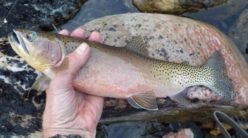Mother’s Day is this Sunday, and in my opinion, there are some pretty amazing wildlife mothers that deserve their very own Mother’s Day celebrations! I am convinced that when it comes to their own kids, they — like human mothers — have eyes in the backs of their heads and know the value of a warm snuggle and the occasional scolding.
Lately, I have had so much fun watching the birds in my neighborhood fly back and forth from yards and nearby open fields with beaks full of nesting material. I have heard from folks on the south side of Pocatello that does are starting to drop fawns. And I am waiting to witness one of my favorite springtime events — a mama duck with her fuzzy offspring obediently in tow.
Though nature’s nursery is a joy to watch, there is something to keep in mind when you visit the great outdoors, even if you are only venturing as far as your own backyard.
When it comes to taking care of animal babies, no one does it better than animal moms. So, if you see a baby bird hopping on the ground or a tiny fawn curled up in the shade of an aspen, leave it alone. Don’t assume the young animal has been abandoned. In almost every situation, the mother is very close by and may even be watching you watch her baby.
Animal parents will periodically leave their young to search for food or to divert attention away from their vulnerable offspring, especially if they sense danger. Young wild animals, like deer fawns, know instinctively to remain still and in the places their mothers left them. The mothers will return every three to four hours to nurse and care for their young. In the meantime, a fawn’s protective coloring and lack of movement helps to hide its location from predators.
Adult birds will often continue to feed their young even if they fall out of the nest. In fact, as chicks grow, mom and dad will actually “encourage” them out of the nest for some supervised flight training.
There are countless examples of adoption in the wildlife world, too. Have you ever seen a pair of Canada geese with about 15 goslings following close behind? Trust me. They didn’t lay 15 eggs — more like six or eight. What happened is that they “inherited” another goose’s brood — kind of like a play date that has no end. Mom and Dad don’t even blink an eye and just treat them just like they are their own.
During the spring and early summer, the Idaho Department of Fish and Game receives a flurry of public phone calls regarding everything from baby owls and goslings to young foxes and fawns. While the first instinct of most callers is to “rescue” the animal by removing it from the wild, this is not always the best solution.
It may seem cold-hearted to just leave a baby animal alone, but imagine how sad it is for a mother to return to an area and find her baby missing. In the case of mule deer, a doe will often hang out in an area for several days, searching and waiting for her missing baby to reappear.
So what do you do if you see a robin fledgling hopping in your backyard, a young fox that looks lost, or a fawn that you think is an orphan? Leave them be. Then contact your local Fish and Game office. Fish and Game employees work for the agency because they truly care about wildlife. They are happy to take calls about orphaned or injured animals, answer questions, and when necessary, retrieve animals.
Fish and Game is committed to helping Idaho’s wildlife. There are times when we have had to place moose calves in a new home or even find a new nest and parents for a baby eagle. But keep in mind that sometimes “helping” means standing back and letting wildlife do what comes naturally. Wildlife mothers truly know best.
To all you mothers out there — with or without fur, feathers and fins — Happy Mother’s Day!
Jennifer Jackson is the Regional Conservation Educator for the Idaho Department of Fish and Game, southeast region.



